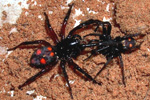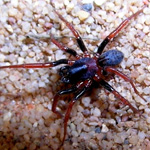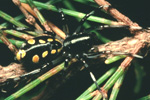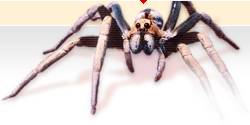
Ant Spiders
Zodariidae Thorell, 1881
(compiled by Barbara Baehr)
Identification
 opens in new window
opens in new window
The Ant Spiders or Zodariidae have a Gondwanan distribution and are found in all tropical and subtropical regions. The spiders are three-clawed, entelegyne, small to large sized (2-20mm) and can easily be identified by the absence of a serrula, the 3rd claw on the onychium, and the medio-lateral inserted teeth on the two main claws.
Biology
 opens in new window
opens in new window
(photo: J. Wright)
Zodariidae are abundant ground-living spiders in Australia, often recognised by their attractive, bright yellow or orange spots against a dark brown abdomen, and by their annulated legs. Little is known of their biology, but some species build a shallow burrow, surrounded by a small palisade of twigs or litter (Mascord, 1970). Other species seem to be wandering, nocturnal hunters, sheltering under rotten logs, stones or any other appropriate place during daylight (Main, 1976). However, most species are diurnal and live together with ants, mimicking their behaviour and sometimes even their chemical traits. For example, Habronestes bradleyi mimics pheromones of meat ants, Iridomyrmex purpureus (Allan et al., 1996). This exceptional mimicry, common in the Zodariidae, has given them the common name ‘ant spiders’.
Zodariidae in Australasia
Australia
 opens in new window
opens in new window
(Foto: M. Glover)
Australia has one of the richest known zodariid faunas, with 224 described species listed in (Norm Platnick`s World Spider Catalog) and at least another 180 undescribed species in Australia’s collections. Over 99% of the species are endemic to Australia. The Australian Ant Spider Fauna consists of tree subfamilies. The Cyriocteinae (1 described species) have a row of strong setae between the anterior and posterior eye row. The Lachesinae (4 described species) are recognised by an ovoid sternum and retractile anterior spinnerets. The two eye rows are only slightly procurved and two rows of long spines on the anterior metatarsi are present. The Storeninae (219 described species) have their anterior spinnerets on a common mound, two strongly procurved eye rows and a preening brush consisting of hollow chisel-shaped setae on the 2nd and 3rd metatarsus.
A generic revision of the Zodariidae (Jocqué, 1991) provided a systematic framework to study the Australian Fauna. From 1991-2001, the genera Storena (Jocqué & Baehr, 1992, 1994 2001), and Cavasteron and Minasteron (Baehr & Jocqué, 2000) were revised. In total, 128 new species have been described in the last four years (Baehr & Jocqué 2001; Baehr 2003a,b,c; Baehr & Churchill 2003; Baehr 2004a,b).
The Zodariidae are listed in the Australian Faunal Directory.
South East Asia
Most genera of the South East Asian Ant Spiders are not revised yet. Murphy and Murphy (2000) list four genera, Asceua, Mallinella, Storenomorpha and Zodarion. Platnick (2004) also catalogued some Storena from South East Asia, however this genus appears to be restricted to Australia.
References
Allan, R.A., Elgar, M.A. and Capon, R.J. 1996. Exploitation of an ant chemical alarm signal by the zodariid spider Habronestes bradleyi Walckenaer. Proceedings of the Royal Society of London, Series B 263: 69-73.
Baehr, B. 2003a. Revisions of the new endemic genera Basasteron, Euasteron and Spinasteron of Australia (Araneae, Zodariidae): Three new genera of the Asteron-complex. Memoirs of the Queensland Museum 49: 1-27.
Baehr, B. 2003b. Revision of the tropical genus Tropasteron gen. nov. of North Queensland (Araneae, Zodariidae): A new genus of the Asteron-complex. Memoirs of the Queensland Museum 49: 29-64.
Baehr, B. 2003c. Revision of the Australian genus Habronestes L.Koch (1872) (Araneae: Zodariidae). The species of NSW. Records of the Australian Museum 55: 343-367.
Baehr, B. (2004a). Revision of the new Australian genus Holasteron (Araneae, Zodariidae): taxonomy, phylogeny and biogeography. Memoirs of the Queensland Museum in press
Baehr, B. (2004b). The systematics of a new endemic Australian genus of ant spiders Masasteron (Araneae: Zodariidae). Invertebrate Systematics in press
Baehr, B. and Churchill, T.B. 2003. Revision of the endemic Australian genus Spinasteron (Araneae, Zodariidae): taxonomy, phylogeny and biogeography. Invertebrate Systematics 17: 641-665.
Baehr, B. and Jocqué, R. 1994. Phylogeny and zoogeography of the Australian genus Storena (Araneae, Zodariidae). Spixiana 17: 1-12.
Baehr, B. and Jocqué, R. 2000. Revisions of the genera in the Asteron-complex (Araneae, Zodariidae). The new genera Cavasteron and Minasteron. Records of the Western Australian Museum 20: 1-30.
Baehr, B. and Jocqué, R. 2001. Revisions of the genera in the Asteron-complex (Araneae, Zodariidae). The new genera Pentasteron, Phenasteron, Leptasteron and Subasteron. Memoirs of the Queensland Museum 46: 359-385.
Jocqué, R., 1991. A generic revision of the spider family Zodariidae (Araneae). Bulletin of the American Museum of Natural History 201: 1-160.
Jocqué, R. and Baehr, B. 1992. A revision of the Australian spider genus Storena (Araneae, Zodariidae). Invertebrate Taxonomy 6: 53-1004.
Jocqué, R. and Baehr, B. 2001. Revisions of the genera in the Asteron-complex (Araneae, Zodariidae): Asteron Jocqué and the new genus Pseudasteron. Records of the Australian Museum 53: 21-36.
Main, B.Y. 1976. Spiders. Collins, Sydney.
Mascord, R. 1970. Australian spiders in colour. Reed Publishers, 112pp.
Murphy, F. and Murphy, J. 2000. An Introduction to the Spiders of South East Asia. Malaysian Nature Society, United Selangor Press Sdn. Bhd.

